Attached files
| file | filename |
|---|---|
| 8-K - FORM 8-K - REGIONS FINANCIAL CORP | d262885d8k.htm |
 2011 Goldman Sachs
US Financial Services Conference
December 6, 2011
Grayson Hall
President and Chief Executive Officer
Exhibit 99.1 |
 Why
Regions? •
Strong Southeastern franchise with comprehensive line
of product offerings
•
Leading brand favorability and exceptional service
quality
•
Solid core business performance
•
Aggressively identifying and disposing of problem assets
•
Capital and liquidity remain solid
2 |
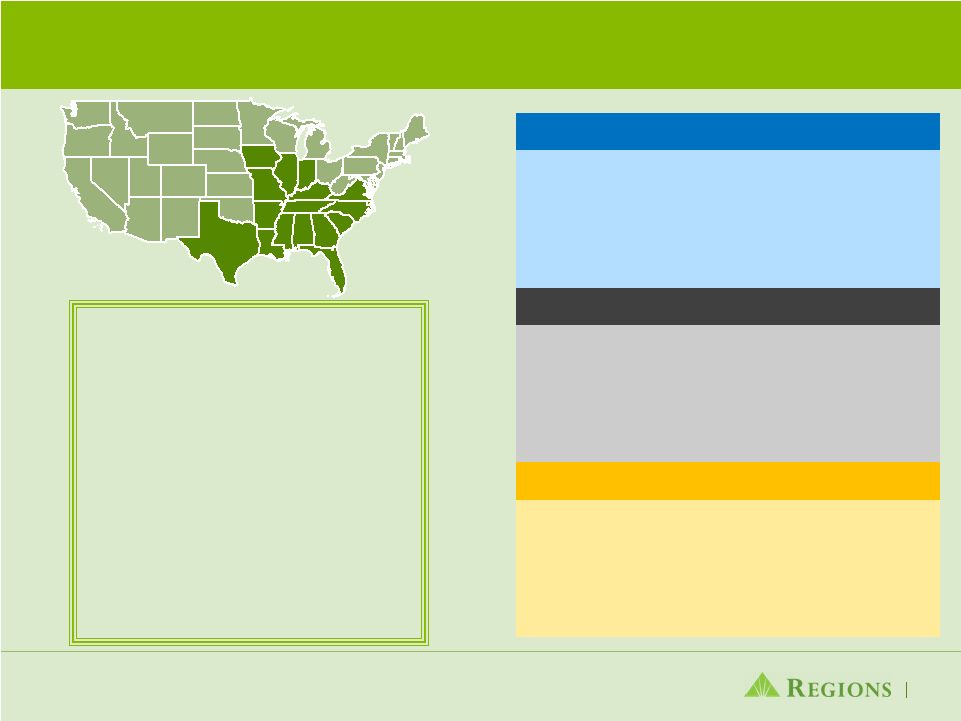 Regional Bank in the Southeast with Comprehensive
and Diversified Line of Product Offerings
3
›
Associates: 26,881
›
Assets: $130B
›
Loans: $79B
›
Deposits: $96B
›
Branches: 1,767
›
Morgan Keegan Offices: 303
›
Insurance Offices: 30
›
ATMs: 2,130
›
Market Cap: $5.3B*
* As of December 2, 2011
Business Services
›
Small and mid-sized C&I lending
›
Commercial Real Estate
›
Equipment Finance
Consumer Services
Wealth Management
›
Private Banking
›
Insurance
›
Trust Services
›
Mortgage
›
Home Equity
›
Credit Card
›
Direct Lending
›
Indirect Auto |
 Top
10 MSAs Deposits
Market
Share
Market
Rank
’10-’15
Population
Growth
Birmingham, AL
$11.0
37.6%
1
Nashville, TN
$6.6
17.3%
1
Miami, FL
$4.8
3.1%
7
Tampa, FL
$4.4
8.7%
4
Memphis, TN
$3.8
16.8%
2
Atlanta, GA
$3.4
3.0%
6
St. Louis, MO
$3.0
4.7%
4
Jackson, MS
$2.8
25.5%
2
New Orleans, LA
$2.4
8.3%
4
Mobile, AL
$2.3
38.2%
1
4
($ in billions)
National Average: 3.9%
Regions’
Footprint is Characterized by Either High
Market Shares, High Growth Markets or Both
Source: SNL Financial
Note: Core Markets include AL, FL, LA, MS, AR, TN
Weighted Average Deposit Market Share
in Regions’
Core Markets
Rank
Name
Market Share
1
Bank of America
11.5%
2
Regions
9.8%
3
Wells Fargo
9.4%
4
SunTrust
6.9%
5
JPMorgan Chase
3.3%
6
BB&T
2.5%
7
Capital One
2.3%
8
First Horizon
2.0%
9
Hancock
1.9%
10
PNC
1.4%
1.0%
8.8%
4.4%
2.0%
10.1
%
4.3%
3.7%
1.4%
9.6%
3.4% |
 Competitive Advantage Driven by Customer
Loyalty
Regions continues to
perform in the top 10%
in customer loyalty and
top 20% for branch
service quality
(1)
(1)
Based on Gallup survey
(2)
Based on Prime Performance study
(3)
2010 Greenwich Excellence Award
#1 in Customer Service and
“Friendliest”
Bank
(2)
Regions received
Excellence Award
for Small Business
and Middle Market
Banking
(3)
5
Top Bank in
Customer
Service Study
Ranked 2
nd
in Satisfaction for
Mortgage Servicing
J.D. Power
AND ASSOCIATES |
 Quality Loans Key to Profitable Growth
61%
39%
Portfolio Mix*
Consumer Services
›
Growing consumer loans to achieve a
more balanced portfolio
›
Consumer loan growth will be fueled by
new businesses as well as growth in
existing businesses
›
Loan production in mortgage
grew 9% over prior quarter
›
Acquired $1.2 billion Regions-
branded credit portfolio
›
Indirect auto lending grew 4%
linked quarter
Business Services
›
Focused on middle market & small
business
›
Represents over 80% of
Business Services Revenue
›
Broad based middle-market
commercial loan growth across
footprint and industries
›
55% of area regions
experienced growth in 3Q11
*Ending Balances
6 |
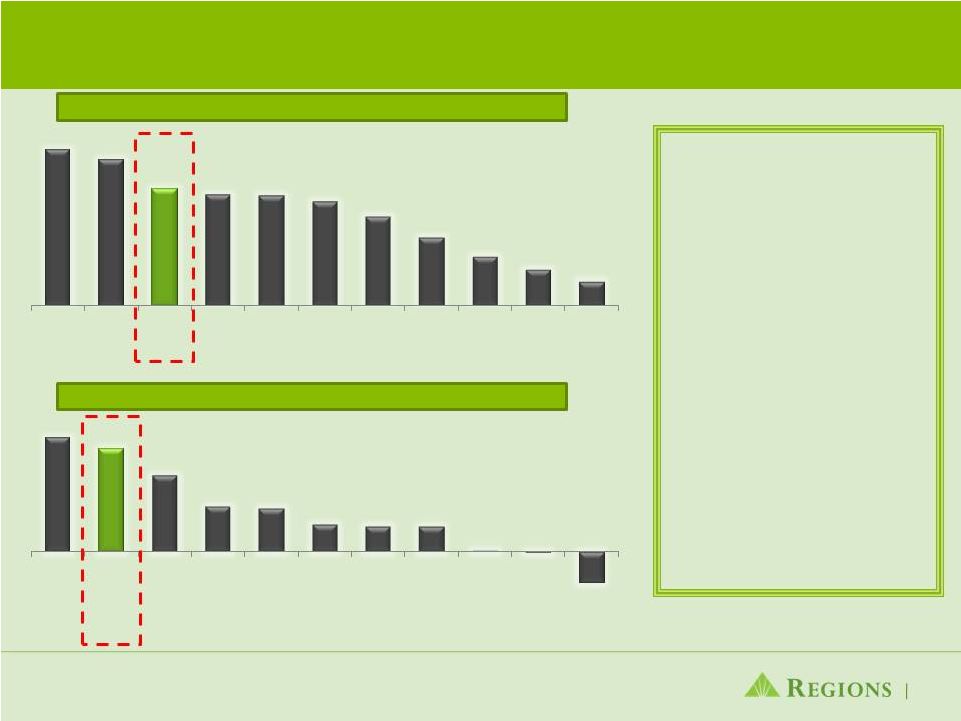 Regions C&I Loan Growth has significantly
outpaced Peers
Source: SNL Financial; FRY-9C Regulatory filings
Note: Peer banks include BAC, BBT, CMA, FITB, KEY, MTB, PNC, STI, USB,
WFC •
Our Commercial &
Industrial loan growth
has significantly
outpaced peers over the
past year
•
Momentum has
continued in 2011, as
Commercial & Industrial
loans have grown
another 12.5%
•
Commercial & Industrial
commitments increased
7% year-to-date and line
utilization remained
stable
Year-To-Date % Change
Loan Growth Since 4Q09
16.7%
15.6%
12.5%
11.9%
11.8%
11.2%
9.5%
7.3%
5.3%
3.9%
2.6%
Bank
#1
Bank
#2
RF
Bank
#4
Bank
#5
Bank
#6
Bank
#7
Bank
#8
Bank
#9
Bank
#10
Bank
#11
27.2%
24.4%
18.2%
10.7%
10.2%
6.4%
6.1%
5.9%
0.2%
-0.3%
-7.3%
Bank
#1
RF
Bank
#3
Bank
#4
Bank
#5
Bank
#6
Bank
#7
Bank
#8
Bank
#9
Bank
#10
Bank
#11
7 |
 Opportunities Remain To Further Lower Deposit
Costs
8
Deposit Cost Opportunity Gap
•
Regions has additional room to reduce deposit costs
even further
•
Opportunity to reduce deposit costs, most significantly
through profitably re-pricing maturing CDs
•
Higher cost CDs maturing
•
4Q11 -
$2.4 B at 1.32%
•
2012 -
$10.7 B at 1.59%
•
$6 billion of cash in Fed Funds at September 30
Note: Peer banks include BAC, BBT, CMA, FITB, KEY, MTB, PNC, STI, USB,
WFC Deposit Mix Compared to Peers
Regions
Peer
Average
40 bps
38 bps
12 bps
8 bps
2Q11
3Q11
Peer Median
Regions Opportunity Gap
Time
22%
NIB
30%
Other
48%
Time
17%
NIB
29%
Other
54% |
 Net
Interest Margin Impacted by Cash Reserves and Non-Accrual Loans
Impact of Excess Liquidity &
Non-Accruals on NIM
9
Regions has closed a portion of its
gap vs. the peers in the last 5 quarters
80 bps
47 bps
Note: Peer banks include BAC, BBT, CMA, FITB, KEY, MTB, PNC, STI, USB,
WFC Reported Net Interest Margin
Impact of Excess Liquidity
Impact of Non-Accruals
2.0%
2.2%
2.4%
2.6%
2.8%
3.0%
3.2%
3.4%
3Q10
2.96%
3.00%
3.07%
3.05%
3.02%
0.08%
0.11%
0.10%
0.13%
0.16%
0.16%
0.16%
0.16%
0.15%
0.14%
3.20%
3.27%
3.33%
3.33%
3.32%
4Q10
1Q11
2Q11
3Q11
3.67%
3.65%
3.63%
3.60%
3.55%
3.49%
2.87%
2.96%
3.00%
3.07%
3.05%
3.02%
2.50%
2.70%
2.90%
3.10%
3.30%
3.50%
3.70%
3.90%
2Q10
3Q10
4Q10
1Q11
2Q11
3Q11
Peer Group Average
Regions |
 Service Charge Income Remains Strong
10
Offsetting Durbin
•
Ongoing restructuring
of our accounts to fee-
eligible
•
Increasing hurdle
obtaining free
checking
•
Cross-sell new
revenue initiatives
Year-To-Date Service Charge Growth
Source: SNL Financial
Note: Peer banks include BAC, BBT, CMA, FITB, KEY, MTB, PNC, STI, USB,
WFC 2.4%
0.5%
-2.5%
-3.2%
-3.8%
-4.4%
-4.7%
-5.7%
-6.5%
-9.5%
-11.4%
RF
Bank
#1
Bank
#2
Bank
#3
Bank
#4
Bank
#5
Bank
#6
Bank
#7
Bank
#8
Bank
#9
Bank
#10 |
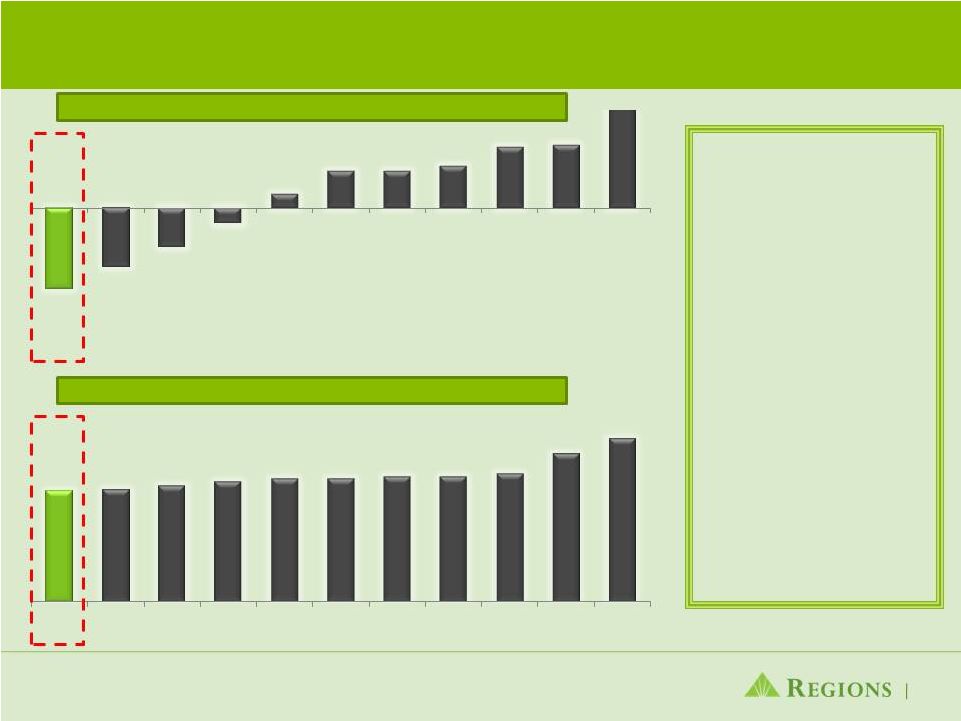 Expense control continues to be a focus
11
•
Year-over-year
Regions’
expenses*
have declined 8%
while many peers
continue to grow
expenses
•
While many peers
grew expenses in the
third quarter, Regions
decreased expenses*
by 5%
•
Expenses per FTE
are among the lowest
of all peers
* On an adjusted basis, refer to appendix for non-GAAP reconciliation
Source:
SNL
Financial
–
excludes
nonrecurring
expenses
Note: Peer banks include BAC, BBT, CMA, FITB, KEY, MTB, PNC, STI, USB,
WFC NM
Year-Over-Year % Change
NIE* Per FTE
-8.3%
-6.0%
-4.0%
-1.6%
1.4%
3.8%
3.8%
4.3%
6.2%
6.4%
RF
Bank
#2
Bank
#3
Bank
#4
Bank
#5
Bank
#6
Bank
#7
Bank
#8
Bank
#9
Bank
#10
Bank
#11
$39.7
$40.1
$41.4
$42.8
$44.0
$44.0
$44.7
$44.7
$45.7
$52.9
$58.3
RF
Bank
#2
Bank
#3
Bank
#4
Bank
#5
Bank
#6
Bank
#7
Bank
#8
Bank
#9
Bank
#10
Bank
#11 |
 * Refer to appendix for reconciliation to GAAP
** Net income available to common shareholders
12
Strong Net Income and Adjusted Pre-tax
Pre-Provision Income Growth
($ in
millions)
Net
Interest
Income
Adjusted
Non-
Interest
Revenue*
Adjusted
Non-
Interest
Expense*
Adjusted
Pre-tax
Pre-
provision
Income*
Net
Income**
3Q11
858
+
748
-
1,066
=
540
$101
2Q11
864
+
757
-
1,121
=
500
$55
1Q11
863
+
764
-
1,167
=
460
$17
4Q10
877
+
795
-
1,211
=
461
$36
3Q10
868
+
748
-
1,162
=
454
($209) |
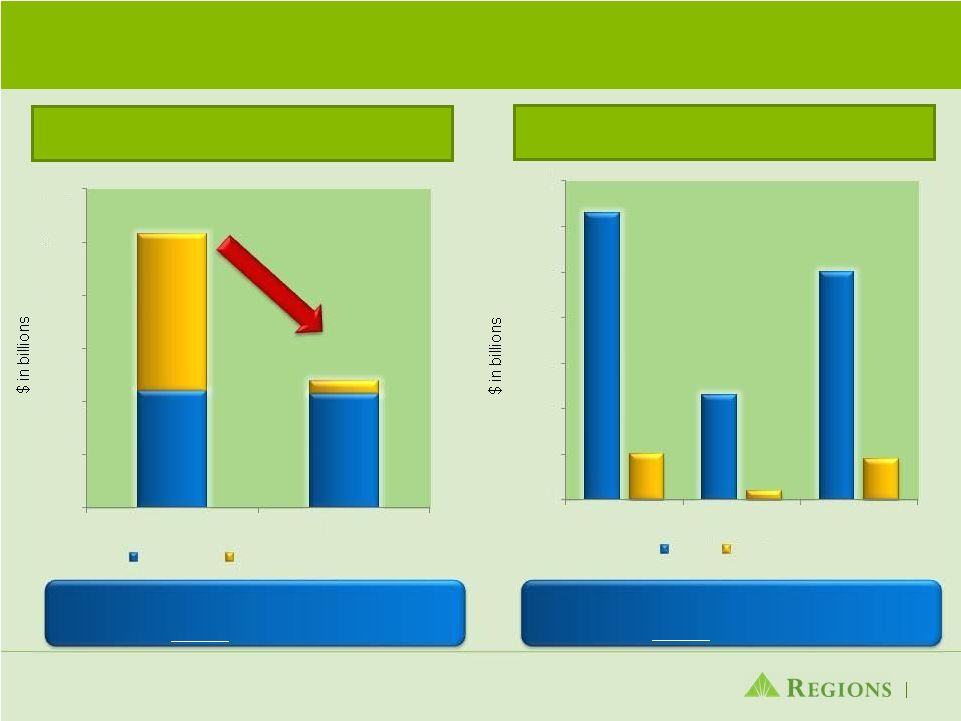 Significant Reduction in
Highest Risk Portfolio Segments
Total Investor Real Estate
Higher Risk Investor Real Estate Segments
13
$14.8
$11.0
$10.7
$1.2
$25.8
$11.9
$0
$5
$10
$15
$20
$25
$30
4Q06
3Q11
$6.3
$2.3
$5.0
$1.0
$0.2
$0.9
$0
$1
$2
$3
$4
$5
$6
$7
Land
Condo
Single Family
Reduced Investor Real Estate $13.9 B
or
54%
over 4 years
Reduced High Risk Segments $11.5 B
or
85%
over 4 years
Mortgage
Construction
4Q06
3Q11 |
 14
Credit Quality Metrics Linked Quarter
Net charge-offs declined 7%
Provided less than net charge-offs for 2
nd
straight quarter
Non-performing loans declined 3%
Non-performing assets declined 6%
Business Services criticized loans declined 8%
Loan loss allowance to net loans declined 11bps to 3.73%
Delinquencies improved for the 6
th
straight quarter |
 Substantial Improvement in Loan Loss Provision;
Allowance Well Above Peers
(1) Loan charge-offs related to Sales and Transfer to Held for Sale
Note: Peer banks include BAC, BBT, CMA, FITB, KEY, MTB, PNC, STI, USB,
WFC 15
Sales/
HFS
(1)
348
402
210
190
160
233
111
106
207
198
178
169
165
151
153
(150)
(156)
$760
$682
$482
$398
$355
($200)
$0
$200
$400
$600
$800
$1,000
3Q10
4Q10
1Q11
2Q11
3Q11
$ in millions
Business Services and HFS
Consumer
Reserve Increase / Reduction
3.77%
3.84%
3.92%
3.84%
3.73%
3.23%
3.11%
3.03%
2.78%
2.62%
3Q10
4Q10
1Q11
2Q11
3Q11
Regions
Peer Average
Loan Charge-Offs
Allowance versus Peers |
 Strong Capital
16
* Non-GAAP
–
see
appendix
for
reconciliation
** Non-GAAP -
Subject to change as interpretation of Basel III rules is ongoing and dependent on
guidance from Basel and regulators; see appendix for
reconciliation 7.6%
7.9%
7.9%
7.9%
8.2%
7.7%
12.1%
12.4%
12.5%
12.6%
12.8%
11.3%
3Q10
4Q10
1Q11
2Q11
3Q11
3Q11
Tier 1 Common*
Tier 1
Basel III** |
 Loans / Deposits
17
Core Deposits as a % of Total Funding
Solid Liquidity
Source: SNL Financial
Note: Peer banks include BAC, BBT, CMA, FITB, KEY, MTB, PNC, STI, USB,
WFC 89%
88%
84%
84%
83%
3Q10
4Q10
1Q11
2Q11
3Q11
89%
89%
88%
86%
85%
85%
84%
81%
81%
78%
56%
Bank
#1
Bank
#2
RF
Bank
#4
Bank
#5
Bank
#6
Bank
#7
Bank
#8
Bank
#9
Bank
#10
Bank
#11 |
 Business Plan Priorities
18 |
 Stronger Company Today
4Q07
3Q11
Change
Investor Real Estate
$23B
$12B
48% Reduction
Allowance for Loan Losses
$1.3B
$3.0B
More than
doubled
Tier 1 Common Ratio*
6.6%
8.2%
160 bps
improvement
Low Cost Deposits
$60.3B
$75.5B
25% Growth
Loan to Deposit
100%
83%
Strong Liquidity
19
* Non-GAAP
–
see
appendix
for
reconciliation |
 Appendix |
 Forward-Looking Statements
This
presentation
may
include
forward-looking
statements
which
reflect
Regions’
current
views
with
respect
to
future
events
and
financial
performance.
The
Private
Securities
Litigation
Reform
Act
of
1995
(“the
Act”)
provides a
“safe harbor”
for forward-looking statements which are identified as such and are accompanied
by the identification of important factors that could cause actual results to differ materially from the forward-looking statements.
For these statements, we, together with our subsidiaries, claim the protection
afforded by the safe harbor in the Act. Forward-looking statements are not based on historical information, but rather are related to future
operations,
strategies,
financial
results
or
other
developments.
Forward-looking
statements
are
based
on
management’s
expectations
as
well
as
certain
assumptions
and
estimates
made
by,
and
information
available
to,
management at the time the statements are made. Those statements are based on
general assumptions and are subject to various risks, uncertainties and other factors that may cause actual results to differ materially from
the
views,
beliefs
and
projections
expressed
in
such
statements.
These
risks,
uncertainties
and
other
factors
include,
but
are
not
limited
to,
those
described
below:
›
The Dodd-Frank Wall Street Reform and Consumer Protection Act (the
“Dodd-Frank Act”) became law on July 21, 2010, and a number of legislative, regulatory and tax proposals remain pending. Additionally, the U.S.
Treasury
and
federal
banking
regulators
continue
to
implement,
but
are
also
beginning
to
wind
down,
a
number
of
programs
to
address
capital
and
liquidity
in
the
banking
system.
Proposed
rules,
including
those
that
are part of the Basel III process, could require banking institutions to increase
levels of capital. All of the foregoing may have significant effects on Regions and the financial services industry, the exact nature of
which cannot be determined at this time.
›
Regions'
ability
to
mitigate
the
impact
of
the
Dodd-Frank
Act
on
debit
interchange
fees
through
revenue
enhancements
and
other
revenue
measures,
which
will
depend
on
various
factors,
including
the
acceptance
by
our customers of modified fee structures for Regions' products and services.
›
The impact of compensation and other restrictions imposed under the Troubled Asset
Relief Program (“TARP”) until Regions repays the outstanding preferred stock and warrant issued under the TARP, including
restrictions on Regions’
ability to attract and retain talented executives and associates.
›
Possible additional loan losses, impairment of goodwill and other intangibles, and
adjustment of valuation allowances on deferred tax assets and the impact on earnings and capital.
›
Possible changes in interest rates may increase funding costs and reduce earning
asset yields, thus reducing margins. Increases in benchmark interest rates would also increase debt service requirements for
customers whose terms include a variable interest rate, which may negatively impact
the ability of borrowers to pay as contractually obligated. ›
Possible changes in general economic and business conditions in the United States in
general and in the communities Regions serves in particular, including any prolonging or worsening of the current unfavorable
economic conditions including unemployment levels.
›
Possible changes in the creditworthiness of customers and the possible impairment of
the collectability of loans. ›
Possible
changes
in
trade,
monetary
and
fiscal
policies,
laws
and
regulations
and
other
activities
of
governments,
agencies,
and
similar
organizations,
may
have
an
adverse
effect
on
business.
›
The current stresses in the financial and real estate markets, including possible
continued deterioration in property values. ›
Regions' ability to manage fluctuations in the value of assets and liabilities and
off-balance sheet exposure so as to maintain sufficient capital and liquidity to support Regions' business.
›
Regions' ability to expand into new markets and to maintain profit margins in the
face of competitive pressures. ›
Regions' ability to develop competitive new products and services in a timely manner
and the acceptance of such products and services by Regions' customers and potential customers.
›
Regions' ability to keep pace with technological changes.
›
Regions' ability to effectively manage credit risk, interest rate risk, market risk,
operational risk, legal risk, liquidity risk, and regulatory and compliance risk.
›
Regions’
ability to ensure adequate capitalization which is impacted by inherent
uncertainties in forecasting credit losses. ›
The cost and other effects of material contingencies, including litigation
contingencies, and any adverse judicial, administrative or arbitral rulings or proceedings.
›
The effects of increased competition from both banks and non-banks.
›
The effects of geopolitical instability and risks such as terrorist attacks.
›
Possible changes in consumer and business spending and saving habits could affect
Regions' ability to increase assets and to attract deposits. ›
The effects of weather and natural disasters such as floods, droughts, wind,
tornados and hurricanes, and the effects of man-made disasters.
›
Possible downgrades in ratings issued by rating agencies.
›
Potential
dilution
of
holders
of
shares
of
Regions’
common
stock
resulting
from
the
U.S.
Treasury’s
investment
in
TARP.
›
Possible
changes
in
the
speed
of
loan
prepayments
by
Regions’
customers
and
loan
origination
or
sales
volumes.
›
Possible acceleration of prepayments on mortgage-backed securities due to low
interest rates and the related acceleration of premium amortization on those securities.
›
The effects of problems encountered by larger or similar financial institutions that
adversely affect Regions or the banking industry generally. ›
Regions’
ability to receive dividends from its subsidiaries.
›
The
effects
of
the
failure
of
any
component
of
Regions’
business
infrastructure
which
is
provided
by
a
third
party.
›
Changes in accounting policies or procedures as may be required by the Financial
Accounting Standards Board or other regulatory agencies. ›
The
effects
of
any
damage
to
Regions’
reputation
resulting
from
developments
related
to
any
of
the
items
identified
above.
The
foregoing
list
of
factors
is
not
exhaustive.
For
discussion
of
these
and
other
factors
that
may
cause
actual
results
to
differ
from
expectations,
look
under
the
captions
“Forward-Looking
Statements”
and
“Risk
Factors”
in
Regions’
Annual Report on Form 10-K for the year ended December 31, 2010 and quarterly
report on Forms 10-Q for the quarters ended September 30, 2011, June 30, 2011 and March 31, 2011, as on file with the Securities
and Exchange Commission.
The words "believe," "expect," "anticipate,"
"project," and similar expressions often signify forward-looking statements. You should not place undue reliance on any forward-looking statements, which speak only as of the date
made. We assume no obligation to update or revise any forward-looking statements
that are made from time to time. 20 |
 We
have made great strides in improving deposit mix and cost and funding
costs Deposit Cost
70 bps
Deposit Cost
53 bps
Deposit Cost
46 bps
7 bps Improvement
24 bps Improvement
Low Cost
Deposits
74%
Time
Deposits
26%
Low Cost
Deposits
77%
Time
Deposits
23%
Low Cost
Deposits
78%
Time
Deposits
22%
Total Funding Cost
102 bps
Total Funding Cost
80 bps
Total Funding Cost
75 bps
27 bps Improvement
21
3Q10
2Q11
3Q11 |
 Non-GAAP Reconciliation
22
($ in millions)
3Q10
4Q10
1Q11
2Q11
3Q11
Net interest income (GAAP)
868
$
877
$
863
$
864
$
858
$
Non-interest income (GAAP)
750
1,213
843
781
745
Adjustments:
Securities (gains) losses, net
(2)
(333)
(82)
(24)
1
Leveraged lease termination (gains) / losses
-
(59)
-
-
2
Loss (gain) on sale of mortgage loans
-
(26)
3
-
-
Adjusted non-interest income (non-GAAP)
748
795
764
757
748
Adjusted total revenue (non-GAAP)
1,616
$
1,672
$
1,627
$
1,621
$
1,606
$
Non-interest expense (GAAP)
1,163
$
1,266
$
1,167
$
1,198
$
1,066
$
Adjustments:
Loss on extinguishment of debt
-
(55)
-
-
-
Securities impairment, net
(1)
-
-
-
-
Branch consolidation and property and equipment charges
-
-
-
(77)
-
Adjusted non-interest expense (non-GAAP)
1,162
$
1,211
$
1,167
$
1,121
$
1,066
$
Adjusted pre-tax pre-provision income
454
$
461
$
460
$
500
$
540
$ |
 Non-GAAP Reconciliation: Capital
23
($ amounts in millions, except per share data)
9/30/11
6/30/11
3/31/11
12/31/10
9/30/10
TIER 1 COMMON RISK-BASED RATIO
Stockholders' equity (GAAP)
17,263
$
16,888
$
16,619
$
16,734
$
17,163
$
Accumulated other comprehensive (income) loss
(93)
177
387
260
(208)
Non-qualifying goodwill and intangibles
(5,649)
(5,668)
(5,686)
(5,706)
(5,729)
Disallowed deferred tax assets
(506)
(498)
(463)
(424)
(427)
Disallowed servicing assets
(36)
(35)
(28)
(27)
(20)
Qualifying non-controlling interests
92
92
92
92
92
Qualifying trust preferred securities
846
846
846
846
846
Tier 1 capital (regulatory)
11,917
$
11,802
$
11,767
$
11,775
$
11,717
$
Qualifying non-controlling interests
(92)
(92)
(92)
(92)
(92)
Qualifying trust preferred securities
(846)
(846)
(846)
(846)
(846)
Preferred stock
(3,409)
(3,399)
(3,389)
(3,380)
(3,370)
Tier 1 common equity (non-GAAP)
K
7,570
$
7,465
$
7,440
$
7,457
$
7,409
$
Risk-weighted assets (regulatory)
L
92,786
93,865
93,929
94,966
97,088
Tier 1 common risk-based ratio (non-GAAP)
K/L
8.2%
7.9%
7.9%
7.9%
7.6%
As of and for Quarter Ended |
 24
Non-GAAP Reconciliation: Capital / Basel III
(1)
Under
Basel
III,
regulatory
capital
must
be
reduced
by
purchased
credit
card
relationship
intangible
assets.
These
assets
are
partially
allowed in Basel I capital.
(2)
Regions continues to develop systems and internal controls to precisely calculate
risk-weighted assets as required by Basel III. The amount included above
is a reasonable approximation, based on our understanding of the requirements.
($ amounts in millions)
09/30/11
Stockholders' equity (GAAP)
17,262
Non-qualifying
goodwill
and
intangibles
(1)
(5,820)
Adjustments, including other comprehensive income related to cash flow hedges,
disallowed deferred tax assets, threshold deductions and other
adjustments (809)
10,633
Qualifying non-controlling interests
4
Basel III Tier 1 Capital (non-GAAP)
10,637
Basel III Tier 1 Capital (non-GAAP)
10,637
Preferred Stock
(3,409)
Qualifying non-controlling interests
(4)
Basel III Tier 1 Common (non-GAAP)
7,224
Basel I risk-weighted assets
92,786
Basel
III
risk-weighted
assets
(2)
94,384
Minimum
Basel III Tier 1 Capital Ratio
11.3%
8.5%
Basel III Tier 1 Common Ratio
7.7%
7.0% |
 Continued Improvement in Early Stage Credit
Metrics
25
90+ Day Delinquencies
30-59 Day Delinquencies
Business Services Criticized Loans *
Business Services Classified Loans
*Includes classified loans and special mention loans
$766
$642
$676
$566
$518
3Q10
4Q10
1Q11
2Q11
3Q11
$593
$585
$527
$483
$412
3Q10
4Q10
1Q11
2Q11
3Q11
$10,593
$9,804
$9,142
$7,900
$7,305
3Q10
4Q10
1Q11
2Q11
3Q11
$7,929
$7,337
$6,688
$5,824
$5,408
3Q10
4Q10
1Q11
2Q11
3Q11 |
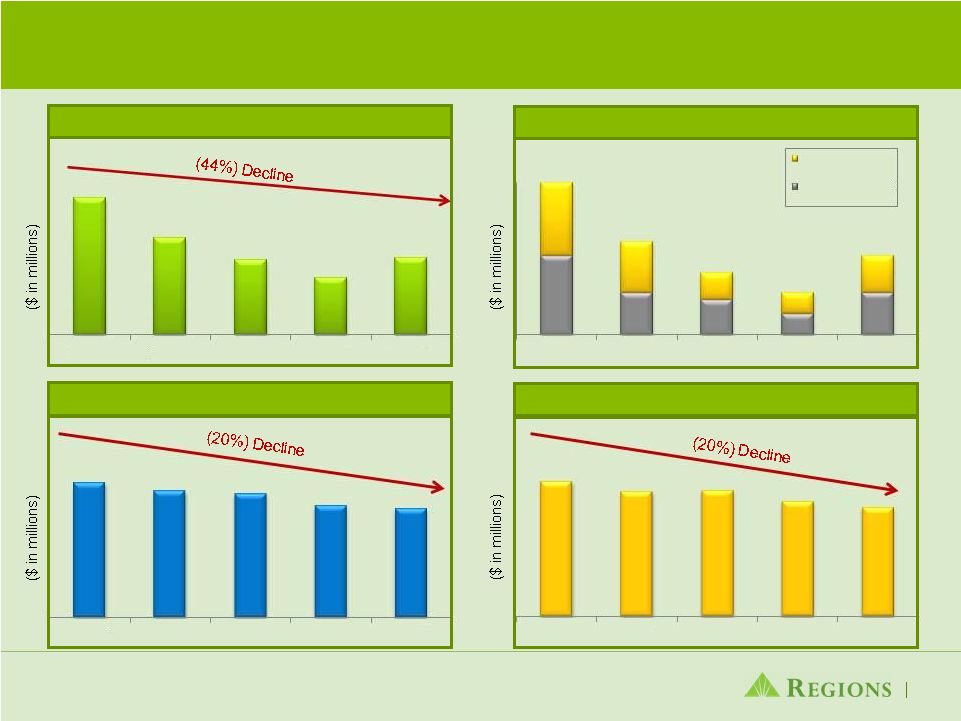 Credit Quality Metrics
26
Total NPLs (excluding HFS)
Total NPAs (including HFS)
NPLs Gross Migration
Investor Real Estate Gross NPA Migration
* Previous presentation showed 2Q11 on a pro-forma basis to include completed
bulk sale after quarter-end. Current presentation shows actual 2Q11 and
3Q11 numbers as reported. $1,340
$947
$730
$555
$755
3Q10
4Q10
1Q11
2Q11
3Q11
516
270
224
134
273
480
335
179
137
245
$996
$605
$403
$271
$518
3Q10
4Q10
1Q11
2Q11
3Q11
Land/Single
Family/Condo
Income
Producing CRE
$3,372
$3,160
$3,087
$2,784
$2,710
3Q10
4Q10
1Q11
2Q11
3Q11
$4,226
$3,918
$3,933
$3,602
$3,391
3Q10
4Q10
1Q11
2Q11*
3Q11 |
 27
Credit Fundamentals
NCO’s Avg Loans
NPAs + 90 day Delinquencies
NPAs + 90 Day Delinquencies/Loans +
OREO + HFS
NPL Balances Paying
Current and as Agreed
* Previous presentation showed 2Q11 on a pro-forma basis to include completed
bulk sale after quarter-end. Current presentation shows actual 2Q11 and
3Q11 numbers as reported. 3.52%
3.22%
2.37%
2.71%
2.52%
3Q10
4Q10
1Q11
2Q11
3Q11
$4,819
$4,503
$4,460
$4,085
$3,803
3Q10
4Q10
1Q11
2Q11*
3Q11
5.65%
5.38%
5.42%
4.98%
4.75%
3Q10
4Q10
1Q11
2Q11*
3Q11
36%
37%
38%
42%
45%
3Q10
4Q10
1Q11
2Q11
3Q11 |
 Allowance Coverage Remains Strong
28
Allowance for Loan Losses to NPLs
(excl HFS)
Allowance for Loan Losses to Total Loans
94%
101%
103%
112%
109%
3Q10
4Q10
1Q11
2Q11
3Q11
3.77%
3.84%
3.92%
3.84%
3.73%
3Q10
4Q10
1Q11
2Q11
3Q11 |
 29
Conservative Marks and Reserves
Already Taken on Impaired Loans
Note1:
Impaired
loans
include
non-accrual
commercial
and
investor
real
estate
loans,
excluding
leasing,
and
all
TDRs
(including
accruing
commercial,
investor
real
estate,
and
consumer TDRs)
Note 2: Book value represents the unpaid principal balance less charge-offs and
payments applied; it is shown before any allowance for loan losses. Note 3:
Unpaid principal balance represents the contractual obligation due from the customer and includes the net book value plus charge-offs and payments applied.
Impaired Loans as of September 30, 2011
A
B
C= (A -
B)
D
E = (B + D) / A
($ millions)
Unpaid
Principal
Balance
Charge-Offs
and Pmts
Applied
Total Impaired
Loan Book
Value
Related
Allowance for
Loan Loss
Coverage %
Total Commercial and Industrial
812
$
86
$
726
$
197
$
34.8%
Total Commercial Real Estate Mortgage -
OO
960
108
852
216
33.7%
Total Commercial Real Estate Construction -
OO
43
15
28
8
54.2%
Total Commercial
1,815
208
1,606
421
34.7%
Total Commercial Investor Real Estate Mortgage
1,847
172
1,675
439
33.1%
Total Commercial Investor Real Estate Construction
552
111
441
171
51.2%
Total Commercial Investor Real Estate
2,399
284
2,116
610
37.3%
Residential First Mortgage
1,168
66
1,102
158
19.1%
Home Equity
447
14
433
61
16.8%
Indirect
2
-
2
0
0.9%
Consumer Credit Card
-
-
-
Other Consumer
59
0
59
1
1.4%
Total Consumer
1,676
80
1,596
220
17.9%
Total
5,890
$
572
$
5,318
$
1,251
$
30.9% |
 30
Adequately Reserved for Troubled Debt
Restructurings
September 30, 2011
Consumer loans make up 50% of accruing troubled debt restructurings
Foreclosure rate less than half of the industry average
($ millions)
Loan
Allowance for
Allowance as a %
Balance
Credit Losses
of Loan Balance
Accruing:
Commercial
477
83
17%
Investor Real Estate
991
252
25%
Residential First Mortgage
888
127
14%
Home Equity
403
57
14%
Other Consumer
60
1
1%
Total Accruing
2,819
520
18%
Non-accrual or 90+ DPD:
Commercial
372
93
25%
Investor Real Estate
474
145
31%
Residential First Mortgage
214
31
14%
Home Equity
30
4
14%
Other Consumer
1
0
1%
Total Non-accrual or 90+DPD
1,091
273
25%
Total Troubled Debt Restructurings
3,910
793
20% |
 |
